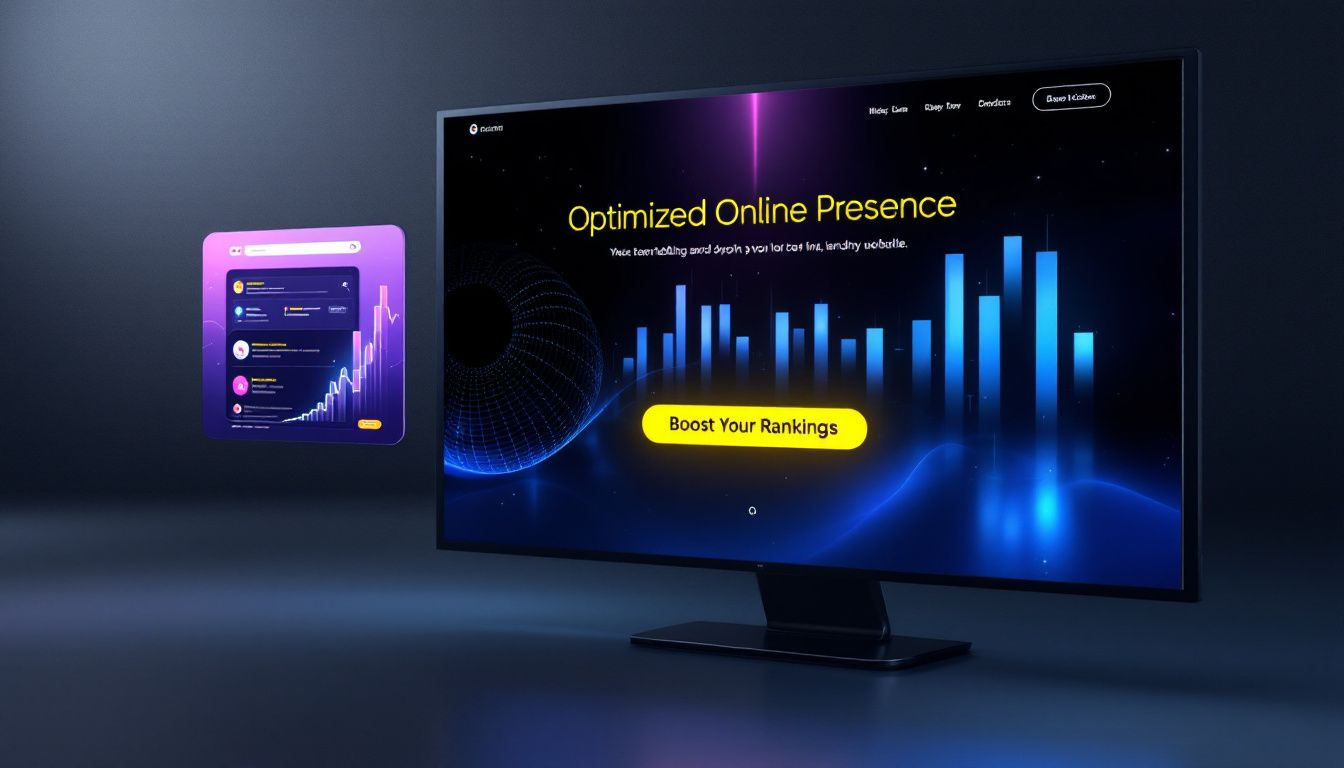Looking to enhance your website’s search engine visibility? Combining website development and SEO strategies can significantly boost your rankings on search engine results pages. In this guide, learn how to integrate essential SEO practices during the website development SEO phase to improve your site’s visibility and user experience.
Website Development SEO Strategy: Key Takeaways
- Integrating SEO early in website development is essential for improving search visibility and user experience.
- Key elements like mobile-first design, page speed optimization, and user-friendly navigation play crucial roles in enhancing SEO effectiveness.
- Ranking high in search results is critical as the first search result captures a substantial portion of clicks, significantly impacting organic traffic and search visibility.
- Regular monitoring of SEO performance and collaboration between SEO and development teams ensure ongoing success and adaptability in strategies.
Understanding Website Development SEO
Integrating search engine optimization strategies within the framework of creating websites is a pivotal aspect of website development SEO. It guarantees that these sites are not merely attractive and simple to navigate, but also readily found by search engines. Elevating both the prominence in searches and the user experience for website visitors is essential for effective website creation.
Merging technical on-page tactics with consumer tastes plays a vital role in harmonizing SEO and web design, ensuring an outcome that meets both aesthetic and functional criteria.
What is Website Development SEO?
It is essential to weave SEO techniques into the fabric of website construction in order to boost its prominence on search engines. The essence of SEO web design lies in formulating websites that not only captivate users but are also straightforward for search engines to catalogue. To elevate a site’s presence in search results, it’s important that both its content and architecture receive attentive consideration through SEO approaches, aiming concurrently at heightened visibility and an enriched user experience.
By incorporating web design elements sensitively attuned to SEO practices, one can facilitate a more intuitive navigation for search engines when interpreting a site’s material, which ultimately favors higher ranking positions. This practice of SEO web design serves dual purposes: optimizing sites so they’re effortlessly processed by various search engine algorithms while simultaneously ensuring visitors encounter a fluid and enjoyable browsing experience.
Importance of SEO in Website Development
Incorporating SEO early in development ensures long-term success in search rankings. SEO best practices assist in ranking for important keywords and maintaining those rankings on search engine results pages. A good SEO strategy supports achieving marketing goals and boosts overall ROI. SEO can significantly improve revenue by driving targeted traffic to a website.
Adopting HTTPS secures user data and is a ranking factor considered by Google. Proper technical SEO practices during website development, such as optimizing metadata, play a crucial role in achieving better search engine visibility.
Focusing on loading speed and responsive design optimizes user experience and positively influences SEO outcomes. Ignoring early SEO integration can lead to poor organic traffic results past the first page of search results.
Key Elements of SEO-Friendly Web Design
SEO-friendly web design involves key elements that enhance both user experience and search engine rankings. A well-designed SEO website design enhances user engagement among website visitors, reduces bounce rates, and increases time spent on site.
Clear site hierarchy assists both users and search engines in understanding the content better. Ignoring proper image optimization can lead to slower loading times, negatively impacting SEO. Indexable and crawlable site elements, clear categories, and a uniform URL structure contribute to an SEO-friendly website.
Mobile-First Design
Designing websites with a mobile-first approach not only enhances SEO but also aligns with the prevalent user habits. Google has adopted mobile first indexing, which prioritizes the mobile version of a website for determining its search result rankings. Essential features of this design strategy include swift loading speeds, adaptable responsive layouts, and straightforward navigation.
It is imperative to have responsive web designs since they transform to fit the device being used by visitors, thereby enriching both their experience and your site’s SEO performance. Considering that more than 50% of all website traffic originates from users on mobile devices, adopting a mobile-first mentality in web design is indispensable.
Page Speed Optimization
Loading speed and mobile responsiveness are key factors affecting SEO rankings. Page speed refers to how fast a page loads after its link is clicked, and tools like PageSpeed Insights can be used to measure it. Nearly 70% of consumers state that page speed affects their purchase decisions, and search engines will rank websites lower on search engine results pages if they have slow loading times.
Improving page load speed involves optimizing image sizes and cleaning up code.
User-Friendly Navigation
Creating an intuitive structure for navigating allows users to find information quickly, thus improving their overall experience on the website. By implementing better navigation strategies, user retention is bolstered as website visitors are more inclined to delve deeper into the site, which can also decrease bounce rates.
It is essential that SEO and web design work hand in hand because this synergy not only draws a higher number of visitors but also boosts the quality of their experience. The term ‘website architecture’ denotes the manner in which pages interconnect within a site, and it’s vital for fostering intuitive navigation. Crafting meticulously organized menus is indispensable to establish such a navigational framework effectively.
On-Page SEO Techniques for Website Development
Incorporating targeted keywords at the beginning and end of your content is vital for boosting visibility in search result outcomes, which in turn fosters user interaction. These on-page SEO strategies are key to enhancing online presence.
The effectiveness of titles and meta descriptions in drawing users from search results can be gauged by looking at click-through rates (CTR).
Keyword Research and Integration
Choose highly-searched keywords with low competition to maximize visibility and rank potential. When selecting keywords, consider listing relevant keywords, using keyword tools, analyzing competitors, and focusing on long-tail keywords to improve your search results on search engine results pages.
Utilize tools like Google’s Keyword Tool to generate effective keywords for content development. Incorporate keywords into URLs as they improve SERP ranking and help match content to user search queries. Conduct keyword research for each page to help search engines understand the focus keywords for ranking purposes.
Meta Tags and Descriptions
Meta tags, which are elements of HTML, deliver vital data about a webpage’s contents to search engines. They hold significant importance since unique title tags offer a clear description of the page’s content and aid in boosting its visibility on search engine results pages. The role of meta descriptions is similar to that of a promotional pitch. They encapsulate the essence of the webpage in an effort to attract clicks, thus increasing the website’s prominence within search results.
For optimal performance when crafting these elements, ensure that title tags do not exceed 60 characters while meta descriptions should be kept under 160 characters.
Structured Data and Schema Markup
The act of exploration and categorization of web content by search engine crawlers is known as crawling. Adding schema markup, which is a form of code, to a website, provides search engines with explicit details concerning the site’s contents. When local schema markup is put into practice, it markedly enhances rankings in local searches and improves the chances of appearing as the top search result, assisting businesses in drawing more region-specific visitors.
Sitemaps are vital in directing search engines towards significant pages on a site, thereby boosting the visibility of the entire website.
Technical SEO Considerations During Development
Technical SEO includes secure website practices (HTTPS), the correct use of tags, and ensuring search engine readability. Ignoring technical SEO can hurt your rankings in search engine results pages.
SEO-friendly web design ensures full accessibility and indexability of a website. Utilizing robots.txt effectively helps manage which parts of the site Google crawls and indexes.
Optimizing URL Structure
Having a clear and descriptive URL structure not only enhances the experience for users, but also aids search engines in comprehending your website. It’s beneficial to incorporate a target keyword into each URL segment, or slug, to increase both clarity and relevance. Consistent structuring of URLs makes it easier for users and search engines alike to navigate through your site.
Providing a sitemap enables Google to discover and index all the web pages on your site more effectively, which can improve their chances of being indexed properly and ranking well in search results.
Implementing HTTPS
Securing your website with HTTPS safeguards the information exchanged between users and your site through encryption, enhancing overall security. Search engines favor HTTPS, considering it a positive attribute that can elevate your website’s ranking on search engine results pages while signaling to visitors that they can trust your platform.
By embracing HTTPS for your site, you protect user privacy and promote a more secure browsing environment. This protection results in increased user retention and engagement due to the confidence it inspires in safety-conscious web surfers.
Ensuring Proper Indexation
It is crucial for the content to be accessible and indexable by search engines, which requires it to be easily navigable and interpretable. Opt for HTML text when presenting primary material, as heavy use of JavaScript may lead to difficulties in crawling and adversely affect site performance.
Utilize a robots.txt file thoughtfully. Employing a ‘disallow’ directive within it can prevent search engines from indexing your web pages. To verify that Google is effectively indexing your content and ensuring it appears in the search result, employ tools such as Google Search Console alongside the URL Inspection tool.
Enhancing Content for SEO
Frequent updates to website content can enhance indexing and increase visibility in search engines by indicating that the content is current. To boost rankings on search engines, it’s crucial to refine various elements of a website, including quality content and user experience for website visitors.
By implementing schema markup, the display of a web page within search results can be significantly improved, which may lead to higher click-through rates. Paying attention to metrics such as bounce rate helps gauge how effectively a site satisfies its visitors’ requirements and interests.
Creating Quality Content
Creating content that is both captivating and educational holds the attention of users, enriching their online journey. For better SEO outcomes, it’s essential to generate exceptional, fresh, and enlightening material tailored to address the inquiries and requirements of your intended audience. Engaging website visitors with such content not only fosters trust but also enhances user interaction, which is crucial for SEO performance.
Establishing credibility via content entails showcasing your knowledge and offering meaningful information to your readership. Search engines give preference to high-caliber content that benefits users by assisting them in finding what they are looking for, which can result in higher positions on search results pages.
Using Alt Tags for Images
Alt tags play a vital role in explaining images to search engines while enhancing the accessibility of content. The optimization of images with these alt tags is essential for both users and search engines.
Providing descriptive alt text can significantly improve how well a search engine understands an image, thus boosting SEO performance and helping your content appear higher in the search result. A concise description that includes pertinent keywords should ideally be part of effective alt text.
Internal Linking Best Practices
An internal linking strategy distributes link equity across the website, boosting SEO and improving visibility on search engine results pages. Internal links enhance user navigation by guiding visitors to related content throughout the site. Use descriptive anchor texts, heavily interlink essential pages, and regularly audit for broken links.
Link to and from important pages.
Monitoring and Analyzing SEO Performance
To gauge the success of your SEO tactics, it is crucial to continuously monitor SEO metrics. Utilizing proficient SEO tools can give a complete perspective on how well a website is doing by keeping tabs on organic traffic, backlinks, and user engagement.
By persistently observing and evaluating these performance indicators, you can refine your SEO strategies accordingly. This strategic adjustment is key for enhancing search engine rankings and improving your position in the search result effectively.
Using Analytics Tools
Google Search Console plays an important role in evaluating SEO effectiveness, while Google Analytics is a crucial instrument for tracking website metrics. These analytics tools can reveal patterns in user behavior and overall site performance, offering essential data that supports the enhancement of web properties and their rankings on search engine results pages.
Through analyzing different device usage statistics presented by these analytics platforms, areas requiring refinement are pinpointed to advance the user experience across diverse situations. SEO checker utilities provide valuable insights on critical indicators like traffic fluctuations and levels of user engagement with the site.
Tracking Key Performance Indicators (KPIs)
Key Performance Indicators (KPIs) are vital measures for determining the effectiveness of SEO tactics. Essential indicators to measure the triumph of SEO include metrics such as organic traffic, bounce rate, and conversion rate. By keeping an eye on elements like organic traffic and conversion rates, one can assess the efficacy of SEO activities.
Conversion rate is pivotal in gauging how successfully a website converts visitors into customers.
Regular SEO Audits
Regular SEO audits maintain optimal website performance and ensure search engine rankings. They help identify technical issues that may hinder search engine rankings. Conducting frequent SEO audits is vital for spotting technical issues and areas needing improvement to enhance search rankings on search engine results pages.
Ongoing audits are necessary to adapt to changes in search algorithms and improve site performance.
Common SEO Mistakes in Website Development
Overlooking the importance of mobile optimization can result in a subpar user experience, which hampers engagement and negatively impacts search engine rankings as a consequence of mobile-first indexing. Prolonged loading durations are not just an annoyance to visitors. They also contribute to higher bounce rates, subsequently diminishing your position within search engine listings and affecting your search result visibility.
An untidy or convoluted website configuration can lead to confusion for both visitors and search engines. This makes it difficult for them to locate pertinent content. Regular technical mishaps during web development can adversely affect your SEO efforts, underlining the need for meticulous consideration of both design elements and site operability.
Neglecting Mobile Optimization
If a website does not work well on mobile devices, visitors may leave quickly. Neglecting mobile optimization can lower search engine rankings on search engine results pages. Over 50% of online time is spent on mobile devices, highlighting the need for mobile-friendly designs.
Mobile optimization is crucial in web design as it directly affects user experience and engagement.
Slow Loading Times
Slow loading times can significantly detract from user experience, leading visitors to abandon the site. Slow load times reduce conversion rates, increase bounce rates, and harm search rankings by lowering the site’s position in the search result.
Slow loading times have a negative impact on SEO due to higher bounce rates and poor user experience. Increased bounce rate directly affects a website’s search engine rankings.
Poor Site Structure
Ensuring a streamlined site structure is crucial not only for an improved user experience, but also for bolstering search engine rankings on search engine results pages, as it makes key content readily accessible. Overly intricate website designs with excessive layers can hinder navigation and diminish the likelihood of pages being indexed by search engines.
Implementing strategic internal linking is fundamental in assisting users to move through the website while simultaneously spreading link authority across various pages. Elevated bounce rates could be symptomatic of an ineffective site architecture that leaves users floundering to locate pertinent information promptly.
Integrating SEO with Web Development Teams
Fostering collaboration between SEO specialists and web developers is crucial for achieving high search engine rankings. Effective communication is essential for ensuring that both SEO and web development teams are aligned in their goals and strategies, ultimately aiming to secure a top search result.
Encouraging regular meetings and brainstorming sessions can improve collaboration and idea sharing between the SEO and development teams.
Early Planning and Communication
Bringing in SEO professionals at the outset of website development is essential for embedding search engine optimization into the fabric of the site, ensuring that significant SEO elements are considered to bolster site performance on search engine results pages. Ensuring early collaboration with these experts helps to harmonize website structure, content creation, and technical components with proven SEO strategies, which is pivotal for elevating search engine rankings.
By employing project management software during this process, there’s a boost in synergy between developers and SEO specialists. This enhances streamlined communication and efficient allocation of tasks within the team dynamics as they work on building out a website. Effective strategy planning paired with clear dialogue plays an instrumental role in weaving together collective efforts necessary to implement robust SEO practices throughout every stage of web development.
Collaborative Tools and Platforms
Figma enables teams that need to work closely together to collaborate on design files in real time. Teams can use communication platforms such as Slack for efficient messaging and sharing of files within the group.
Direct feedback and approval of designs are improved by using tools like Filestage, which refine the review process. Platforms such as Slack help to simplify conversations and share updates among team members efficiently, ultimately enhancing site performance and improving the search result ranking.
Continuous Learning and Adaptation
Maintaining a current understanding of the newest SEO tendencies and modifications to search engine algorithms is imperative for sustaining a robust online presence. Employing analytics tools to consistently track performance allows identification of potential enhancements within your SEO approach. It’s important to evolve one’s SEO strategies by paying attention to how users interact with content and their feedback, as well as how these strategies impact your ranking on search engine results pages.
Participating in communities and forums dedicated to SEO offers access to crucial knowledge regarding industry standards and effective techniques. Commitment towards continuous learning through resources like webinars or interactive sessions can significantly advance expertise in both Search Engine Optimization (SEO) and the broader field of web development.
Summary
Crafting the best website development SEO strategy involves a multifaceted approach that integrates technical, on-page, and content-based SEO practices from the ground up. By understanding the key elements of SEO-friendly web design, implementing best practices for on-page SEO, addressing technical SEO considerations, and continuously monitoring and refining strategies, you can achieve higher rankings on search engine results pages and improve user engagement. Remember, SEO is an ongoing process that requires continuous learning, adaptation, and collaboration between SEO specialists and web development teams. Start implementing these strategies today to see a significant boost in your website’s performance and visibility.
Website Development SEO Strategy: Frequently Asked Questions
Why is mobile-first design important for SEO?
Optimizing your site with a mobile-first design is crucial for SEO because Google uses the mobile version of your website as the primary source for indexing and ranking. By focusing on mobile, you can improve your online visibility and attract more users, thereby driving success for your digital footprint.
How does page speed affect SEO?
Page speed is an essential aspect of SEO, as it improves user experience, lowers bounce rates, and elevates your search engine rankings.
By optimizing your website to load more quickly, you can expect an increase in visitor numbers!
What are meta tags, and why are they important?
Meta tags are essential HTML elements that convey crucial information about your web page to search engines, boosting its visibility and encouraging more clicks.
By optimizing them, you enhance your chances of reaching a larger audience and driving traffic to your site!
Why is HTTPS important for SEO?
HTTPS is crucial for SEO because it not only secures user data but also boosts your website’s ranking and trustworthiness in search engines.
Embrace HTTPS and watch your site’s visibility improve!
What is the role of internal linking in SEO?
Enhancing your website’s SEO can be significantly bolstered through internal linking, which serves to increase link equity, aid in user navigation, and assist search engines in understanding the layout of your content.
Leverage this potent strategy to amplify your visibility on the internet!
Take your business to the next level with a Pixel Fish Website.
Check out some of our latest Website Design projects.
Further Information
Why you should use Elementor for your new WordPress Website
What is Google My Business and how can it benefit my business
10 Reasons Your Website Is Fundamental to the Growth of Your Business
WordPress Web Design Sydney: Professional Solutions for Your Next Website Project
Get the Best Custom Website Design Solution for Your Business
The Ultimate Guide to Choosing the Right Website Development Partner: Navigate Your Options with Confidence






